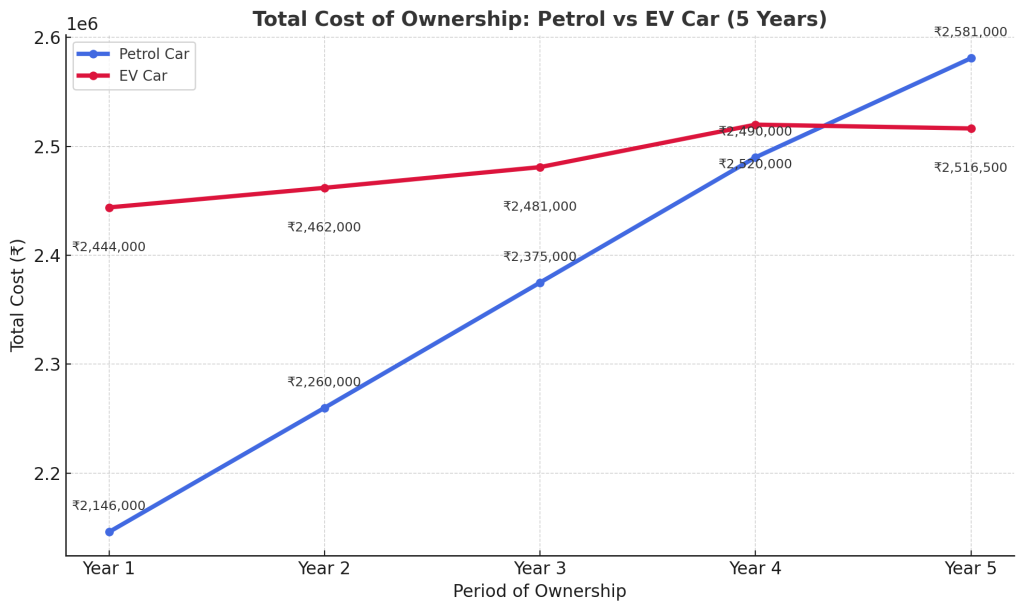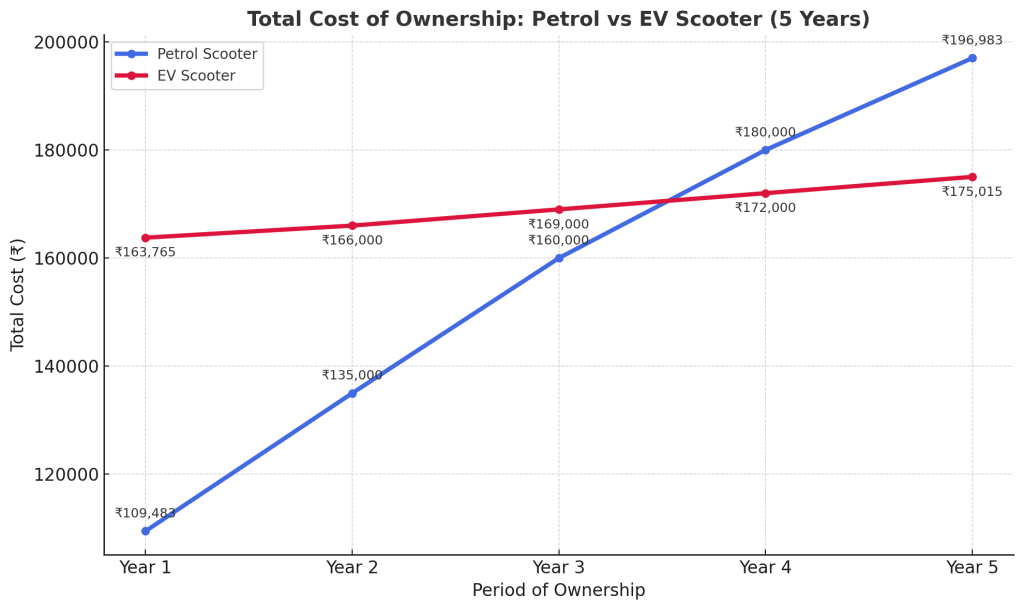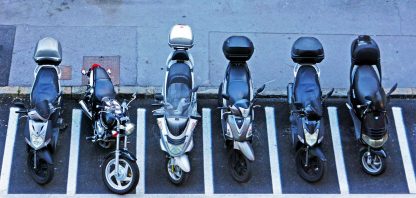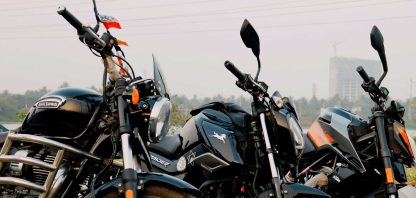Meet the Mehtas.
A middle-class family from Ahmedabad who have managed to save ₹1.55Lakh per year with a smart investment in a combination of EVs and Rooftop Solar. Their power and fuel bills have come down by 80%.
How? Below is their step-by-step journey for you to explore.
The Problem:
The Mehtas, like many business families of Ahmedabad, live in a 3-bedroom independent house with air conditioning in every room. They also drove a petrol SUV and a scooter for their commute.
They use air conditioning for about 7-8 months a year and their average power bill is about ₹8,000 per month. They use their car for daily commute to work, business meetings, and for some joy rides on holidays. They also go on road trips 5-6 times a year. Their overall car usage is about 10,000km a year.
The elder daughter primarily uses the petrol scooter for her daily commute to her college. The scooter usage is about 5000km a year. Let us look at a breakdown of their costs:
1. Power cost:
₹8,000 per month = 8000 x 12 = ₹96000 per year @₹7 per unit, amounts to a consumption of 96000/7 = 13,714 units per year or 1143 units a month
| Monthly | Yearly | |
| Cost (in ₹) | 8000 | 96000 |
| Consumption (in Units) | 1143 | 13714 |
2. Petrol cost:
a. Car: Usage:
| Mileage = 12kmpl |
| Cost of Petrol= ₹90 per litre |
| Monthly | Yearly | |
| Usage (in km) | 833 | 10000 |
| Petrol Consumption (in litre) | 69 | 833 |
| Cost (in ₹) | 6250 | 75000 |
b. Scooter: Usage
| Mileage = 40kmpl |
| Cost of Petrol= ₹90 per litre |
| Monthly | Yearly | |
| Usage (in km) | 417 | 5000 |
| Petrol Consumption (in litre) | 10 | 125 |
| Cost (in ₹) | 938 | 11250 |
The total expenditure on power, petrol car, and scooter adds up to ₹1,82,250 per year.
The Solution:
Mrs and Mr Mehta got to know that Rooftop Solar plants were not only accessible and affordable but also could be a money saver in a high energy consumption household like theirs.
With an investment of about ₹4,00,000 (4Lakh), they installed an on-grid solar plant on their terrace. The solar plant was supplying electricity to the power grid and soon they started understanding the magnitude of what they had installed.
Soon, they realised that coupling the solar plant with EVs might just be a silver bullet to the rising fuel cost. They switched to an EV car and subsequently bought an EV scooter as well.
This is what their current energy cost looks like:
| Solar Plant Capacity: 8kW | ||
| EV Car Battery Capacity: 59kW | Range: 400km | Annual Usage: 10,000km |
| EV Scooter Capacity: 3.7kW | Range: 110km | Annual Usage: 5,000km |
| Charging Efficiency | 87.50% |
| Monthly | Yearly | |
| Electricity Production (4kW per 1kW installed capacity per day) | 973 | 11680 |
| Electricity Consumption sans EV (Units) | 1143 | 13714 |
| Charging cycles for EV Car | 2 | 28 |
| Charging cycles for EV Scooter | 4 | 51 |
| EV Car Power Consumption (Units) | 138 | 1659 |
| EV Scooter Power Consumption (Units) | 16 | 189 |
| Incremental Electricity Consumption due to EV charging (Units) | 154 | 1849 |
| Total Electricity Consumption (Units) | 1297 | 15563 |
| Electricity Bill – Older (₹) | 8000 | 96000 |
| Fuel Cost – Older (₹) | 7188 | 86250 |
| Total Cost – Older (₹) | 15188 | 182250 |
| Net Consumption (Total Consumed – Total Power supplied to the grid) (Units) | 324 | 3883 |
| Electricity Bill – New (₹) | 2266 | 27178 |
| Fuel Cost – New (₹) | 0 | 0 |
| Total Cost – New (₹) | 2266 | 27178 |
| Savings | 12921 | 155072 |
After installing the Rooftop Solar Plant and switching to EVs, the Mehta family managed to save ₹1.55Lakh per year.
The Question: They are saving money but they did have to invest additional money to switch to EVs and install Rooftop Solar.
Does the incremental cost justify the savings?
Let us analyse the investment made and the total cost of ownership.
| Vehicle | Purchase Price (₹) | Cost per km (₹) | Usage (km) | Cost of Annual Service (₹) | Cumulative Cost of Ownership (₹) | ||||
| Year 1 | Year 2 | Year 3 | Year 4 | Year 5 | |||||
| Petrol Car | 2146000 | 7.5 | 10000 | 12000 | 2233000 | 2320000 | 2407000 | 2494000 | 2581000 |
| EV Car | 2444000 | 1.25 | 10000 | 2000 | 2458500 | 2473000 | 2487500 | 2502000 | 2516500 |
Total Cost of Ownership Petrol vs EV Car

The total cost of ownership of a petrol car overtakes that of the EV car in the 4th year and eventually keeps climbing at a higher rate, thanks to higher servicing costs for vehicles older than 5 years.
| Vehicle | Purchase Price (₹) | Cost per km (₹) | Usage (km) | Cost of Annual Service (₹) | Cumulative Cost of Ownership | ||||
| Year 1 | Year 2 | Year 3 | Year 4 | Year 5 | |||||
| Petrol Scooter | 109483 | 2.5 | 5000 | 5000 | 126983 | 144483 | 161983 | 179483 | 196983 |
| EV Scooter | 163765 | 0.25 | 5000 | 1000 | 166015 | 168265 | 170515 | 172765 | 175015 |
Total Cost of Ownership Petrol vs EV Scooter

The total cost of ownership of a petrol scooter overtakes that of the EV scooter in the 4th year and eventually keeps climbing at a higher rate.
Even without introducing Rooftop Solar into this equation, over a span of 4 years, the EV counterparts already make economic sense.
Does the Rooftop Solar break even on its own? Would it have made sense without coupling it with EVs?
The answer to both questions? Yes.
The Solar plant breaks even in less than 5 years. The life of a solar plant is at least 25 years and this becomes a fully amortized investment for the remainder 20 years. Couple this with the fact that EVs help foster a great ecosystem–and now things make great economic sense, alongside the positive environmental impact.
Final Word:
For those people who have private terrace space and are medium to heavy users of Petrol/diesel vehicles, having a combination of a Rooftop Solar plant and EVs makes perfect sense.
If you have air conditioning running for the majority of the year? go for a Solar Plant that matches your sanctioned load instead.
Want to know more about all of this? Write to us at support@ecozaar.in or reach out to me personally.


 Share
Share
 0
0


